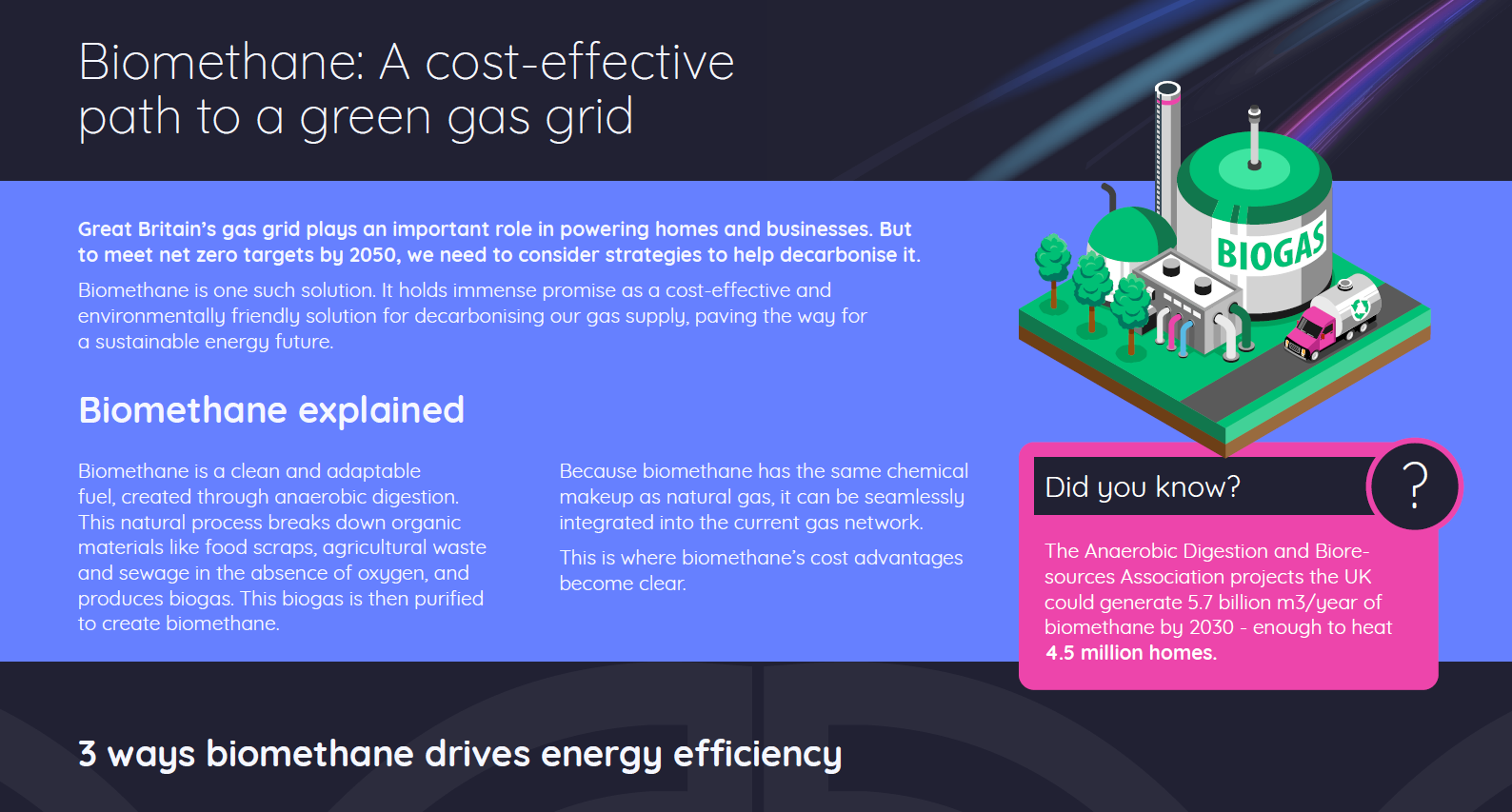Biomethane
Learn about biomethane, a renewable gas that can help decarbonise the natural gas grid, reduce emissions and support a circular economy.
What is biomethane?
Biomethane is a sustainable and versatile energy source produced from the breakdown of organic matter.
A purified form of biogas, biomethane fuel is created when organic materials like food waste, agricultural residues or sewage decompose in the absence of oxygen - a process known as anaerobic digestion.
Biomethane’s value chain
The value chain highlights the key stages in biomethane’s journey, from production to end use.
Biomethane production starts with gathering organic feedstocks like waste from agriculture or food. These are anaerobically digested, producing biogas. This biogas is then purified, removing impurities like CO2, to create biomethane.
Purified biomethane can be injected into existing natural gas pipelines. Where pipelines are unavailable, it's compressed or liquefied for truck transport. Monitoring systems ensure quality and pressure during transit.
Biomethane serves the same purposes as natural gas: heating, electricity, vehicle fuel and industrial processes. Using biomethane in these applications reduces carbon emissions.
Biomethane's role in decarbonisation
Explore the four key ways biomethane makes the natural gas grid more sustainable.
- Direct replacement - Biomethane is chemically identical to natural gas, allowing it to be injected directly into the existing gas grid with no need for costly infrastructure upgrades.
- Diversifying energy - Biomethane offers the chance to reduce our reliance on fossil fuels and lower carbon emissions, while diversifying the energy mix, making the grid more secure and resilient.
- Powerful pathway - It complements electrification efforts by providing a powerful pathway for sectors where electrification is challenging, such as heavy transport and industry.
- Reliable stability - Easily stored and with a more predictable output than renewable sources like solar and wind power, biomethane can help balance energy supply and demand, making the grid more stable.
-
 Biomethane: A cost-effective path to a green gas grid
Biomethane: A cost-effective path to a green gas gridOur helpful infographic explains how biomethane provides a cost-effective solution to decarbonisation.
PDF, Last Updated 17/10/2025, 1.1 MB
The UK’s biomethane strategy
The government sees biomethane fuel as an important piece of the net zero puzzle, helping to reduce greenhouse gas emissions from heating, transport and industry - especially given that it can be used in gas blending.
We currently await a future biomethane policy framework from the government. We anticipate this will clarify future funding mechanisms and biomethane's strategic value in the UK.
Initiatives such as the Green Gas Support Scheme, which has been extended till 2028, are likely to form part of the framework. This scheme provides financial support to biomethane plants injecting gas into the grid, aiming to boost production and make it economically viable.
Similarly, the Green Gas Certification Scheme (GGCS) helps producers realise the full value of their gas by acting as a register for Renewable Gas Guarantees of Origin (RGGOs). It does this by making sure only one RGGO is issued for each unit injected, ensuring accurate accounting and building trust in the product.
The UK Emissions Trading Scheme (ETS) applies a zero emissions factor to combustion of biomethane supplied directly to ETS installations via a dedicated pipeline. However, where biomethane is injected into the gas grid, there is not currently a mechanism to ensure biomethane is accounted for separately. The government may look to change this with their updated policy framework.
When comparing Europe’s and the UK’s biomethane strategies, there are many similarities. Both recognise biomethane’s potential as a vital tool to decarbonise the gas grid and enhance energy independence.
The two also stress the importance of boosting domestic production, taking advantage of existing gas infrastructure and using government support mechanisms to encourage growth.
However, the EU has set more ambitious targets for biomethane production as part of its REPowerEU initiative, with the aim of achieving 35 billion cubic meters of sustainable biomethane production annually by 2030.
The EU is also pushing for greater standardisation and integration across member states, to create a more unified biomethane market. In contrast, the UK’s approach is more cautious, with a more gradual stance on biomethane development.
After the UK ETS was introduced to replace the EU ETS in the country in 2021, there have been key differences between them, including:
- Varying ETS permit prices, with a large quantity of free allowances introduced by the UK Government meaning the cost per tonne has been consistently higher in the EU than the UK.
- A carbon price floor mechanism which the UK introduced in 2013 and has only been adapted by the Netherlands in the EU.
- Emissions caps which differ slightly between the two, with the UK’s falling in line with net zero and the EU’s Linear Reduction Factor (LRF) set at 2.2% a year till 2030.
- The potential expansion of the scheme’s scope, with the EU considering the inclusion of buildings and transport and the UK consulting on the inclusion of waste and greenhouse gas removal techniques.
- Providing you can supply a biomethane GoO and the related Proof of Sustainability, you can claim zero emissions in the EU ETS for biomethane injected into the gas grid, unlike in the UK.
Although there is some talk of linking the two ETS systems together, it’s unlikely to happen until the above misalignments are resolved.
Alongside the ETS, the EU has the Union Database for Biofuels (UDB), which became operational in 2024. This tracks the transactions of liquid and gaseous biofuels across the European market. It ensures their traceability and origin so they can be counted towards the share of renewable energy in the transport sector of any EU member state.
.
Did you know?
According to the Institution of Gas Engineers and Managers (IGEM) there are currently 128 biomethane sites connected to the gas grid, with capacity for over 10 TWh of renewable gas production.
Furthermore, the Anaerobic Digestion and Bioresources Association projects that biomethane could deliver 6% of the UK's gas demand by 2030.
The benefits of biomethane
Biomethane offers various environmental, economic and social benefits.
Achieve sustainability ambitions
Biomethane significantly lowers greenhouse gas emissions compared to fossil fuels, and could play a vital role in helping reach net zero goals. It prevents methane release from organic waste and displaces fossil gas in the energy system.
Supports improved air quality
Biomethane combustion produces fewer harmful pollutants than traditional fossil fuels, contributing to a cleaner air environment.
Towards a circular economy
Because biomethane uses waste matter, it diverts these materials away from landfill sites. As a result, it reduces the harmful emissions associated with landfills, such as nitrogen oxides (NOx), particulate matter (PM) and methane.
Creates job opportunities
Biomethane production supports local jobs in more rural areas, from feedstock collection and processing to plant operation and maintenance. Plus, it can be integrated with farming practices for an even more sustainable approach in the agricultural sector.
Unlocks new revenue streams
By using their organic waste, a range of organisations - from waste management companies and food processors - can create new revenue streams.
Enhance energy security
With the UK government’s focus on energy independence, domestically produced biomethane reduces the country’s reliance on fossil fuels, enhancing energy security.
Better waste management
Instead of simply throwing away organic waste, biomethane production transforms it into a valuable energy source, reducing pressure on landfills and minimising environmental harm.
Empowering local communities
By providing access to affordable and sustainable energy, biomethane can help create new opportunities for businesses, farms and households in areas with more limited energy options.
Investing in our future
Biomethane is a powerful tool in the fight against climate change. It can help decarbonise our energy systems and build a more resilient and environmentally responsible society.
Daily Biomethane Injections Report
The aggregated Daily Biomethane Injections Report was introduced by XRN 5183 to provide visibility of historical and current daily biomethane injection statistics.
This information informs future biomethane projects and helps increase the use of biomethane in the energy industry.
-
 Daily Biomethane Injections
Daily Biomethane InjectionsThe latest monthly figures on the aggregated Daily Biomethane Injections Report.
XLSX, Last Updated 9/12/2025, 147.3 KB
Common queries
The terms ‘biogas’ and ‘biomethane’ are often used interchangeably - but they represent different phases in the process of producing renewable gas from organic matter. Biogas is the raw material, whereas biomethane is the refined product.
Its precise composition will depend on the kind of organic material used, but biogas typically contains between 50-70% methane. Produced directly as a result of anaerobic digestion, biogas can be used for a range of applications, including combined heat and power generation, electricity and space heating. But its lower methane content makes it unsuitable for injecting directly into the natural gas grid.
In contrast, biomethane is a purified form of biogas. It’s created from upgrading biogas through various technologies, such as membrane separation, water scrubbing, pressure swing adsorption, chemical absorption and cryogenic distillation. As a result, its methane content is typically between 95-99%, meaning it can be used for any application that uses natural gas. This makes it a highly valuable renewable energy source.
It’s common for biomethane to be referred to as a ‘carbon neutral’ fuel - but the truth is a little more complicated.
Say the organic matter used is plant material. This will have absorbed CO2 as it was growing, which is then released back into the atmosphere during the biomethane process. This creates a carbon loop, with effectively no more CO2 being created.
Yet the process of producing and upgrading biomethane requires energy, which may come from fossil fuels and adds to the overall carbon emissions generated.
Other factors might affect whether biomethane is carbon neutral as well. For instance, the process of clearing land to specifically grow crops for biomethane production can release carbon stored in the soil, adding to carbon output. Methane leakages from anaerobic digesters are a potential risk too.
On the other hand, should the organic matter for biomethane come from food waste or manure, it could actually be carbon negative. These materials would have decomposed over time regardless, releasing methane into the atmosphere. Instead of letting this methane escape, biomethane production captures it and puts it to good use.
While a renewable energy source with considerable sustainable benefits, it’s vital to consider the full environmental impact of biomethane.
For instance, anaerobic digestion requires water for processes like cooling and cleaning. Yet efficient water management practices and water recycling can minimise water usage.
Another consideration is emissions. Small amounts of ammonia and hydrogen sulphide can be released during biomethane production, but effective management and treatment technologies can reduce this risk.
And while digestate, a byproduct of anaerobic digestion, is a valuable fertilizer, its use on agricultural land needs careful management. Excessive nutrients like nitrogen and phosphorus can run off into waterways, harming aquatic life and impacting water quality. By carefully monitoring nutrient levels, timing applications and integrating digestate use with other sustainable farming practices, it’s possible to maximise its benefits while protecting precious water resources.
More information
If you want to know more about any of the above please email us at decarbonisation@xoserve.com.
